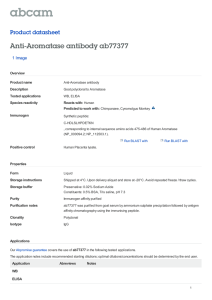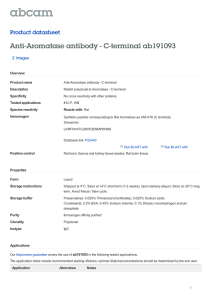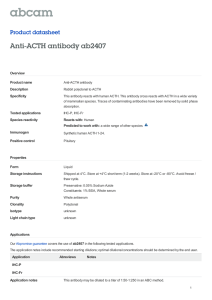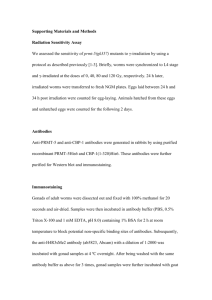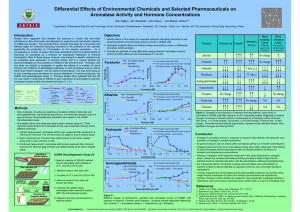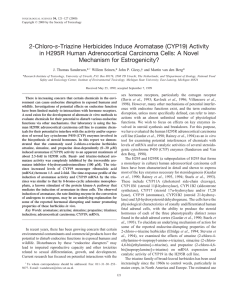Anti-Aromatase antibody ab35604 Product datasheet 4 Abreviews 3 Images
advertisement
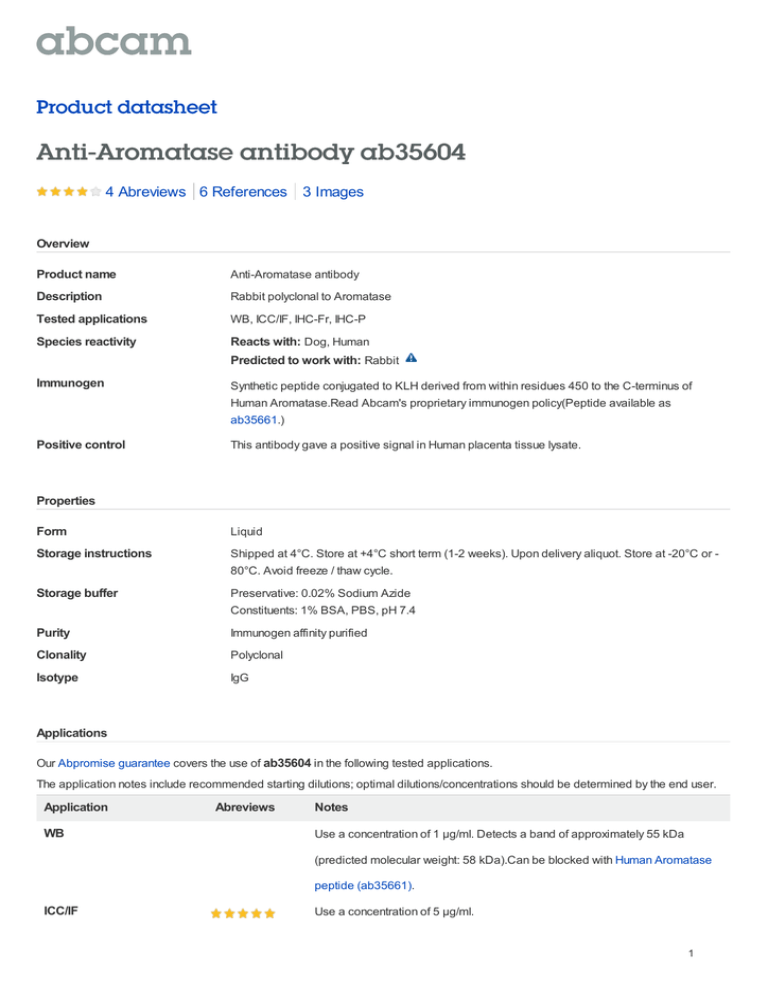
Product datasheet Anti-Aromatase antibody ab35604 4 Abreviews 6 References 3 Images Overview Product name Anti-Aromatase antibody Description Rabbit polyclonal to Aromatase Tested applications WB, ICC/IF, IHC-Fr, IHC-P Species reactivity Reacts with: Dog, Human Predicted to work with: Rabbit Immunogen Synthetic peptide conjugated to KLH derived from within residues 450 to the C-terminus of Human Aromatase.Read Abcam's proprietary immunogen policy(Peptide available as ab35661.) Positive control This antibody gave a positive signal in Human placenta tissue lysate. Properties Form Liquid Storage instructions Shipped at 4°C. Store at +4°C short term (1-2 weeks). Upon delivery aliquot. Store at -20°C or 80°C. Avoid freeze / thaw cycle. Storage buffer Preservative: 0.02% Sodium Azide Constituents: 1% BSA, PBS, pH 7.4 Purity Immunogen affinity purified Clonality Polyclonal Isotype IgG Applications Our Abpromise guarantee covers the use of ab35604 in the following tested applications. The application notes include recommended starting dilutions; optimal dilutions/concentrations should be determined by the end user. Application WB Abreviews Notes Use a concentration of 1 µg/ml. Detects a band of approximately 55 kDa (predicted molecular weight: 58 kDa).Can be blocked with Human Aromatase peptide (ab35661). ICC/IF Use a concentration of 5 µg/ml. 1 Application Abreviews Notes IHC-Fr 1/50. IHC-P Use at an assay dependent concentration. Perform heat mediated antigen retrieval before commencing with IHC staining protocol. Target Function Catalyzes the formation of aromatic C18 estrogens from C19 androgens. Tissue specificity Brain, placenta and gonads. Involvement in disease Defects in CYP19A1 are a cause of aromatase excess syndrome (AEXS) [MIM:139300]; also known as familial gynecomastia. AEXS is characterized by an estrogen excess due to an increased aromatase activity. Defects in CYP19A1 are the cause of aromatase deficiency (AROD) [MIM:107910]. AROD is a rare disease in which fetal androgens are not converted into estrogens due to placental aromatase deficiency. Thus, pregnant women exhibit a hirsutism, which spontaneously resolves after post-partum. At birth, female babies present with pseudohermaphroditism due to virilization of extern genital organs. In adult females, manifestations include delay of puberty, breast hypoplasia and primary amenorrhoea with multicystic ovaries. Sequence similarities Belongs to the cytochrome P450 family. Cellular localization Membrane. Anti-Aromatase antibody images 2 Anti-Aromatase antibody (ab35604) at 1 µg/ml + Placenta (Human) Tissue Lysate adult normal tissue (ab29745) at 20 µg Secondary Goat Anti-Rabbit IgG H&L (HRP) preadsorbed (ab97080) at 1/5000 dilution developed using the ECL technique Performed under reducing conditions. Western blot - Anti-Aromatase antibody (ab35604) Predicted band size : 58 kDa Observed band size : 55 kDa Exposure time : 150 seconds This blot was produced using a 4-12% Bistris gel under the MOPS buffer system. The gel was run at 200V for 50 minutes before being transferred onto a Nitrocellulose membrane at 30V for 70 minutes. The membrane was then blocked for an hour using 5% Bovine Serum Albumin before being incubated with ab35604 overnight at 4°C. Antibody binding was detected using an anti-rabbit antibody conjugated to HRP, and visualised using ECL development solution. ab35604 staining Aromatase in dog ovary tissue section by Immunohistochemistry (Frozen sections). Tissue underwent fixation in acetone for 10 minutes and blocked in TBS buffer (1%BSA + 10%NGS) for 2 hours at 25°C. The primary antibody was diluted 1/50 and incubated with sample for 16 hours at 4°C. A HRP conjugated goat polyclonal to rabbit IgG (H&L), diluted 1/100 was used Immunohistochemistry (Frozen sections) - as secondary. Aromatase antibody (ab35604) This image is courtesy of an Abreview submitted by Dr David Matlack 3 ICC/IF image of ab35604 stained HepG2 cells. The cells were 4% formaldehyde fixed (10 min) and then incubated in 1%BSA / 10% normal goat serum / 0.3M glycine in 0.1% PBS-Tween for 1h to permeabilise the cells and block non-specific protein-protein interactions. The cells were then incubated with the antibody (ab35604, 5µg/ml) overnight at +4°C. The secondary antibody (green) was Alexa Fluor® 488 goat anti-rabbit IgG (H+L) used at a 1/1000 dilution for 1h. Alexa Fluor® Immunocytochemistry/ Immunofluorescence - 594 WGA was used to label plasma Aromatase antibody (ab35604) membranes (red) at a 1/200 dilution for 1h. DAPI was used to stain the cell nuclei (blue) at a concentration of 1.43µM. This antibody also gave a positive result in 4% formaldehyde fixed (10 min) HeLa cells at 5µg/ml. Please note: All products are "FOR RESEARCH USE ONLY AND ARE NOT INTENDED FOR DIAGNOSTIC OR THERAPEUTIC USE" Our Abpromise to you: Quality guaranteed and expert technical support Replacement or refund for products not performing as stated on the datasheet Valid for 12 months from date of delivery Response to your inquiry within 24 hours We provide support in Chinese, English, French, German, Japanese and Spanish Extensive multi-media technical resources to help you We investigate all quality concerns to ensure our products perform to the highest standards If the product does not perform as described on this datasheet, we will offer a refund or replacement. For full details of the Abpromise, please visit http://www.abcam.com/abpromise or contact our technical team. Terms and conditions Guarantee only valid for products bought direct from Abcam or one of our authorized distributors 4
